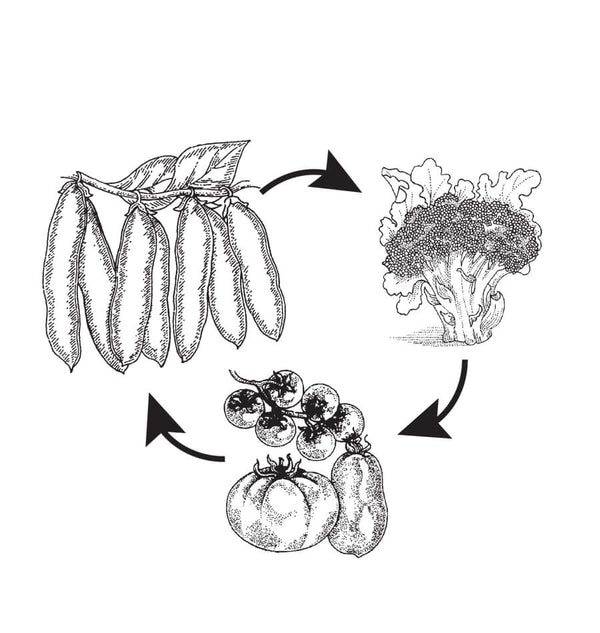Support Food Banks Canada with every dollar spent — 15% sales donated from Black Friday to Cyber Monday.
Time remaining:
Time remaining:

Crop rotation is the practice of not growing plants where similar plants grew the previous year. Crop rotation prevents the build up of pests and diseases and optimizes the use of soil nutrients. Plants from different “families” need different amounts of...
Continue ReadingIn our relatively short growing season, we need to grow most food crops in a fairly intense way. We need to select crops that mature quickly. Some crops, like mescluns and salad greens grow so fast that we can take...
Continue ReadingAuthor and blogger Andrea Bellamy recommends these varieties for container growing on balconies and in other small spaces. These seeds are perfect for the urban grower or part-time farmer who lacks garden space, but wants to grow a little food....
Continue ReadingThe first average frost date for Lower Mainland BC is November 2. This date is reflected pretty closely from the Sunshine Coast and Gulf Islands, coastal Vancouver Island, Puget Sound, and down to the Willamette Valley in Oregon. That means...
Continue ReadingHere's our list of seeds to start in August for fall and winter harvests. These fast-growing seeds are cold hardy, and will thrive as the nights get cooler in late August and September. Check the first average frost date for...
Continue ReadingWhy limit your garden’s production to just the summer? There are still lots of seeds to start in July, particularly in regions with mild winters. Many of these varieties can be enjoyed as mature plants for fall and winter harvests,...
Continue ReadingLettuce is recorded in ancient Egypt, described in carvings at a temple in Karnak, and was thought to be an aphrodisiac. It was also grown in Asia for at least as long. The Latin name Latuca is derived from lac, meaning “milk,” a reference to the milky juice that appears when it is cut. Curiously, the milky juice that gave lettuce its name contains a substance called Lactucarium, which is similar in properties to opium, though much milder.
Continue ReadingSome vegetable varieties thrive in the cool conditions of fall and early winter, and offered a bit of protection from extreme cold, they can be harvested right through until spring. The best winter gardening varieties actually improve in flavour, texture,...
Continue ReadingPlanting for fall & winter harvests has to start in the summer and fall. Just like we sow summer harvest crops in the late winter and spring – it’s the same concept. Did you know that many crops can be...
Continue ReadingAs far as the calendar is concerned, spring is half over, despite the sense for many of us in 2017 that is yet to begin! There are still dozens of seeds to start in May. It can still be cold...
Continue ReadingFor many of us growing up, lettuce represented the primary source of vegetable greens in our diets. Lettuce is absolutely standard in sandwiches and burgers, and makes a simple, inoffensive base for salads. Its flavour is mild and neutral — not too...
Continue ReadingThe last average frost date for south coastal British Columbia is March 28. March is the month gardeners in this region must use to get ready to take full advantage of the growing season ahead. Gardeners in other regions can refer...
Continue ReadingWest Coast Seeds has conducted significant research into the companion planting guidelines and has defined the best possible results and reasons for each of our recommendations in our companion planting chart, below are a few thoughtful suggestions for you while planning your garden this year.
Continue ReadingThe plant above is spinach, and it’s getting ready to bolt. As we approach the summer solstice, the spring garden is transformed into something quite different. Various plants begin to behave in new ways. Growth really kicks in for vine-forming...
Continue ReadingNow we’re just three weeks away from the longest day of the year (summer solstice on June 21st), so the soil is warm enough to plant squash and bean seeds. Even in colder climates where the nights are still frosty,...
Continue ReadingThese instructions will help you plan your garden, making a cloche greenhouse configuration, choose your covering material and pipe frame. Then they will help you set up your greenhouse and make the very best use of it for great gardening...
Continue ReadingWinter is finally over, and spring has arrived. It’s time to plant seeds! Many gardeners make the mistake of thinking of seed planting as a one time, annual event, as though it was something to get over and done with...
Continue ReadingBack on Day 2 of our Twenty-one Days of Green, we talked about planting chives. We chose chives because they have to be among the very simplest of all herbs to grow from seed. They are extremely useful in the...
Continue ReadingWith careful planning, seeds can be sown from winter to autumn in order to keep the garden productive pretty much all year round. Here are some tips for seed sowing for the longest harvest window. Determined growers sometimes think of...
Continue ReadingBaby leaf lettuces are bred for their appeal at an immature stage. As baby greens they have traits that are particularly attractive for salad mixes. The leaves are succulent and tasty, with good texture, and they come in a variety...
Continue ReadingThere are many combinations of plants for interplanting – which combination suits your needs the most? One way of maximizing the return from garden space is to interplant crops. This is the practice of planting one kind of crop, and...
Continue Reading